Introduction to Music Production:
Week 5 - Algorithmic & Convolution Reverb
Nyk Cowham
Introduction

Hello, my name is Nyk Cowham and I am an English guitarist living in Thailand.
This week I will compare and contrast the two main types of reverberation effects: algorithmic and convolution reverb. So let's get started!
What Will We Learn?
- What is reverberation
- Reverb in music production
- What is algorithmic reverb
- What is convolution reverb
- How to use them
- How they compare
What is reverberation?
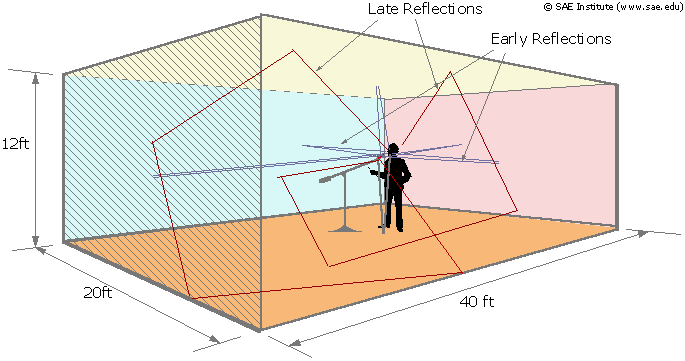
Reverberation is the reflection of sound by multiple surfaces at different distances that return attenuated copies of the original sound, but with different arrival times (delay).
Huh? What is reverberation?
Reverberation relates to the property of sound that was introduced in week one of this course: the property of propagation. Real spaces contain reflective surfaces, and when a sound meets a surface some of the sound energy gets absorbed by the surface material, but the rest of the energy is reflected, which is heard as a copy of the sound that is separated by a small delay. The further away the surface, the longer the delay. Since each surface absorbs some of the energy, each reflected copy of the sound will have lost some amplitude; it will be attenuated. That means the reflected copy (the wet) will not sound as loud as the original sound (the dry). Different surface materials will also absorb sound energy at different frequency ranges, though these are typically in the high end of the sound spectrum.
Reverb in Music Production

There is a category of sound effects available for simulating the propagation parameters associated with real spaces. When we record audio we often go to great pains to remove all surface reflections in the environment to get a clean sound. However, that results in a rather musically lifeless and disembodied audio track, so we would like to be able to re-add that sense of space back into the mix, to give the sound body and depth: a true sense of space.
Reverb effects satisfy this need in our toolbox.
What are reverb effects used for?
- Simulate a real musical performance space
- Craft beautiful sonic environments
- Isolate parts of the mix in creative ways
- Focus the listener's attention

Algorithmic Reverb
Reverberation is defined mathematically and is controlled by changing the values of various parameters relating to sound propagation, such as delay, room size and shape, etc.
Where convolution reverb is analogous to a sampler, algorithmic reverb is analogous to a synthesizer. The delays are synthesized mathematically.
Using Algorithmic Reverb
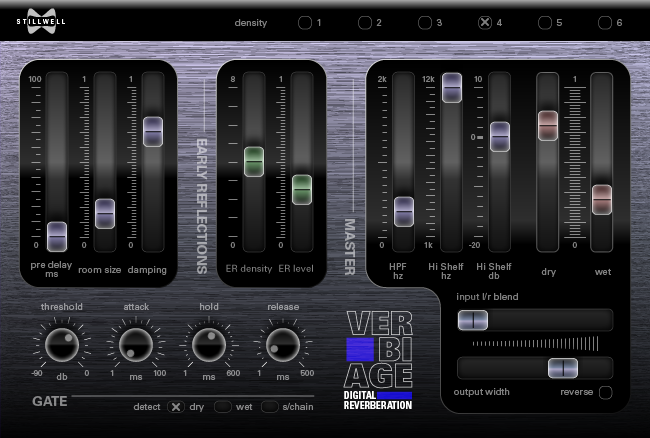
There can be quite a variety of parameters that can be included by plugin developers, but we can mention what is typical.
Early Reflection & Diffuse Reverb
Most plugins distinguish between "early reflection" parameters and "diffuse reverb" settings. Early reflection is similar to running a set of slap back short delays. It represents surfaces that are close to the sound source, like nearby walls, ceilings, etc.

Room Size & Room Shape
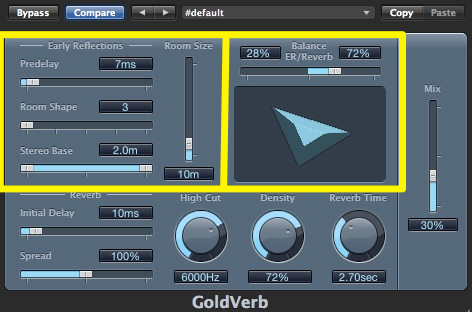
These settings allow you to model the number of reflective surfaces (room shape) and the distance those surfaces are from you (room size). These, along with predelay are parameters associated with the early reflection part of the reverb.
Diffuse Reverb
The main settings typically provided with the diffuse reverb (aka late reverb) portion of an algorithmic reverb plugin are:
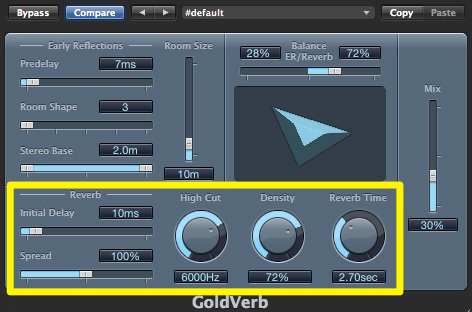
- Reverb time
- High Cut / EQ
- Density
- Spread
Reverb Time
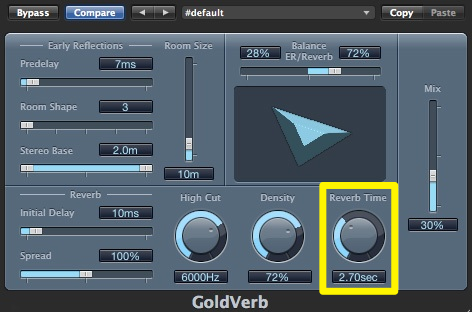
The reverb time controls the volume or size of the space being modelled. In most cases we want to keep this below two seconds. Few large spaces have greater than two seconds natural reverb time, so anything over two seconds will tend to sound unnatural.
High End & Density
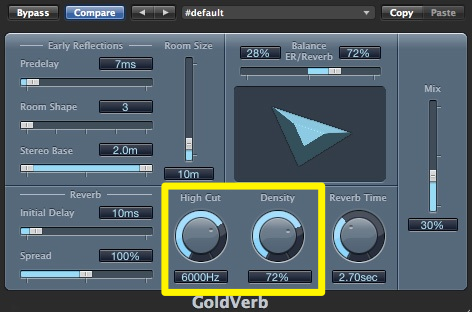
These parameters model different attributes of surface materials. The sound absorbing effect of soft materials, like the fabric in curtains, can be simulated by filtering the high end frequencies using a high end filter. Hard solid materials like stone, that tend to reflect sound, can also be simulated by adjusting the density. The higher the density of surfaces, the more sound they will reflect.
Spread
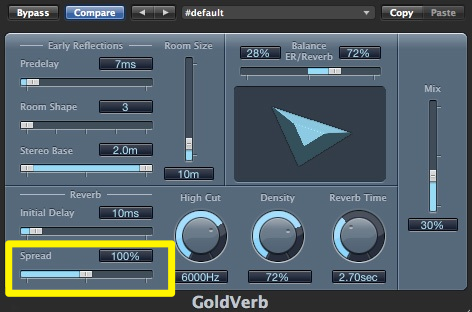
Where the delay time tends to control the overall sense of the volume of a space, the spread allows us to adjust the apparent width of the space by adjusting the stereo spread of the sound. This parameter is the diffuse reverb equivalent to the stereo base setting for the early reflection settings in the above reverb plugin (GoldVerb). The way we process stereo sound is one of the key ways we build our natural subjective experience of space and direction.
Convolution Reverb
Convolution reverb uses an Impulse Response (IR) to create a reverb. This impulse response represents how the sound changes as it travels through an environment. Typically, these impulse responses are sampled from measurements of real physical acoustic environments.
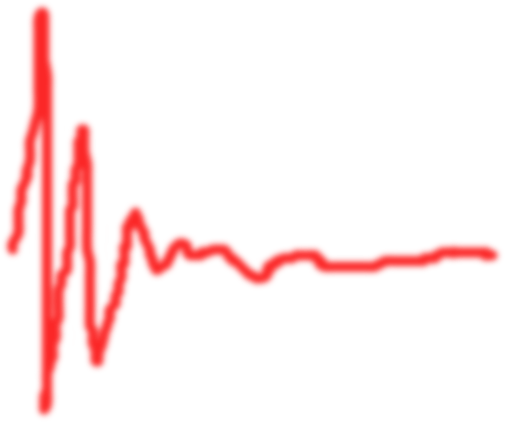
Recording Impulse Responses
An impulse response is typically generated by recording the reflected sounds returned from a short pulse or impulse of sound. That is exactly why we call them impulse responses.
Using Convolution Reverb
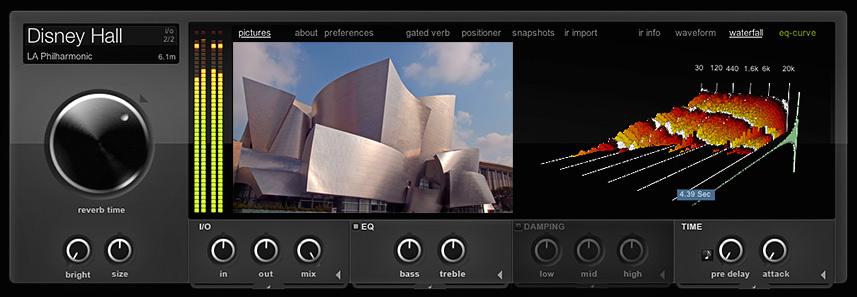
The reverb plugin typically has a method for selecting an impulse response sample for a particular space or type of space. A limited range of additional settings like EQ, delay, etc are also often provided. However, the range of controls are far fewer than what is found in algorithmic reverb plugins.
Reverb Types Compared
| Algorithmic | Convolution |
|---|---|
| Modelled with math. | Based on sampled sounds. |
| Do not sound as natural. | Sound like a real space. |
| Flexible customization. | Has less flexibility to tweak settings. |
| Lightweight processing. | Computationally expensive (more CPU) |
There is a trade-off for the natural sound that convolution reverb gives you, in terms of the amount of CPU time it requires. However, both types of plugin can be used in a mix. It is possible to use algorithmic reverb for individual tracks (focus, isolating the sound, etc) and a convolution plugin to model an environment for the entire mix.
Summary
This week we learned:
- about reverberation / reverb
- how it relates to propagation of sound
- reverb effects in music production
- types of reverb: algorithmic & convolution reverb
- how to use those effects
- how they compare
- what the trade-offs are and how both types
can best be used together in a single mix or project
Thank you for your time, and I hope that you found this a useful revision of the course material!